| WORKSHOPS Links:
Painting Flowers - Mandy Southan
Colour Mixing - Mandy Southan
Decorative Effects - Leonard Thompson
Dyeing Devores - Caroline Munns
Silk Choker Necklace - Linda Graves
Wax Melting Pots - Jill Kennedy
Gutta Pro-liners - Isabella Whitworth
Javana Air Pen - Isabella Whitworth
Microwave Dyeing - Vera Dreyfuss
Painting Borders - Tessa Barnes
Ten Top Tips - Jill Kennedy
Transferring designs - Anon
Free-style landscapes - Marianne Nash
Painted Silk Poppy - Mandy Southan
Magic Lettering - Leonard Thompson
Painted Lilies - Mandy Southan
The Silk Road - Mandy Southan
Aspects of Design - Leonard Thompson
Selling your work - Ian Bowers
Japan: Textiles - Mandy Southan
|
|
THE SILK ROAD - Mandy Southan
An edited form of this article was published by The Artist magazine
in January 2006 - www.theartistmagazine.co.uk
Mandy Southan shares her enthusiasm for the glowing colours of dyes painted on
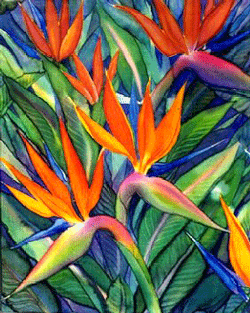 |
 |
Birds of Paradise Flowers
I first discovered silk painting when I was a young art student studying textile design, and was immediately captivated by the wonderful colours and the extraordinary way that the dyes blended on the silk. I used it for many years for hand painted fabrics and it is only in more recent years that I became aware of it’s potential as a ‘fine art’ medium. The distinction between ‘fine art’ and ‘craft’ is, I think’ rather misleading. When I was at art school, there was a definite perception that ’fine art’ - painting and sculpture- was somehow more serious, important and worthy than the areas of design and craft. There was an implication somewhere that as a craft or design student you had in some way ‘sold your soul’ to the god Mammon- your work was tainted by the pursuit of money, design briefs and other external parameters. The true artist had a future of noble poverty in a garret! This may in some cases be true, of course, but at the same time I think that a work of art, whether it be carved, painted, filmed or created using any other medium needs to contain that somewhat indefinable element of ‘Quality’. Quality is perhaps some sort of synthesis between craftsmanship (or technical expertise) and pure creative expression. This element can be found in a piece of silk painted with dyes just as much as it can be found in a piece of canvas painted with oils or acrylics. Any distinction therefore between fine art and craft is, perhaps, artificial. Anyway, having said that, the term fine art in this context refers to making framed paintings or paintings composed within a defined border to hang on a wall rather than wear or use in some other way, and in which the process of making involves some level of commitment to creative expression.
Painting on silk has a long history, dating back to the Han dynasty in China. In Japan, Screens and Kimono are still produced using traditional methods often involving stitched, bound or rice flour resists, but the type of silk painting we practice now, using liquid dyes and acrylic-based silk paints, is a relative newcomer to the art world. Liquid dyes and guttas only became available in the U.K. in the mid 1970’s. This means that silk painting still has much unexplored potential as a fine art medium. It is still fairly difficult to get galleries to accept framed silk paintings, the perception being that if they are executed with dyes on silk they are textiles not ‘art’, despite the fact that a framed and glazed silk painting is as robust as a water colour ( in fact more so as a fixed silk painting is washable!). For this reason many silk artists will term their work ‘water colour on silk’ or ‘aquarelle on silk’ to try to avoid this misconception. However, attitudes are gradually changing as the unique beauty of the medium becomes more widely appreciated. |
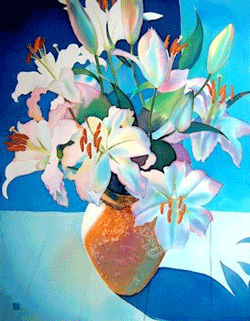 |
|
Lilies in a Stone Pot
Silk painting has great potential as a fine art medium, and is, as yet, largely unexplored by the majority of artists. It has specific characteristics, the most remarkable being the quality of colour which can be achieved. The special colourants used for silk painting are vibrant, especially the steam- fix dyes. The colours can be intermixed and diluted with water to make subtle tints and tones. Silk reflects light in an extraordinary way and the shimmering and slightly textured surface absorbs and reflects colour as no other painting support does. If you adore colour as I do, it is definitely worth trying this magical medium.
I work in oils, water colour and pastels as well as on silk and find silk painting combines my love of textiles with my love of painting. Each medium has it’s own potential and limitations and I like to choose the medium which I feel will best express the subject I want to paint. For me, silk painting is particularly suited to flowers as the colours are so pure and silk lends itself to the delicacy and sheen of petals. Like water colour, it is also a wonderful medium for capturing light effects - the subtle change of tone within a shadow or the rich interplay of reflected light on surfaces. |
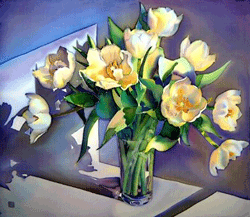 |
|
Morning Tulips
I am fascinated by colour and have spent many hours experimenting mixing colours and discovering how colour actually works in painting. I use a very limited palette of pure hues and intermix them to create a wide range of muted tones. Nearly all my paintings are made with a maximum of 4 of my basic 6 colours. In this way I can keep a painting unified and also keep control of the colour mixing. the fewer colours you use the less likely you are to produce dull muddy tones. Shadow colours should be rich and vibrant - never lifeless grey.! For this reason I never use black. I mix all my very dark tones with red, yellow and blue. my basic palette consists of 2 blues - one a violety blue - ultramarine and the other a greeny blue like cyan; 2 reds - one a violety red - magenta and the second an orangey red like a poppy red. The 2 yellows are a golden yellow which tends towards orange and lemon yellow with a bias towards green.
Painting on silk shares many characteristics with water colour, being a transparent medium in which colours can be built up in washes. The main difference, apart from the intensity of the colours is the fact that the paints and dyes spread freely on the silk so need to be contained by barriers. These barriers usually take the form of fine lines of wax or gum which penetrate the fibres of the silk to stop the flow of the colour. Gutta and wax are the traditional materials used to form resist lines. Spirit - based gutta is a liquid latex rubber which is applied to the silk using a small bottle fitted with a metal nib. In recent years, a number of water based guttas and coloured outliners in tubes have been developed which wash out of the finished painting or remain as a metallic or coloured line. Wax, commonly used in Indonesian batik, is heated and brushed or printed on, or applied in fine lines or dots using a tool called a canting. Layers of wax will resist subsequent washes of colour and will retain areas of previously painted colour. |
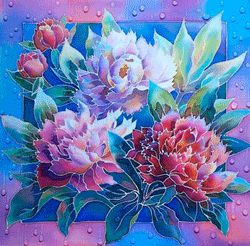 |
|
Peonies in the Rain
Many different types of silk can be used to paint on. The main thing to check is that it does not have any dressing or finishing in it which would prevent the dye from soaking in properly. A good test to see if silk will paint is to put a drop of water on it. If it sits on the surface in a bead it is not going to be easy to paint! It is best to buy silk which is suitable for dyeing and printing from a wholesaler or silk painting supplier. My favourite silk is a medium weight crepe de chine. It absorbs a lot of dye and reflects colour marvellously. A good inexpensive silk to start with is habotai - no. 5 for experimental work and no. 8 for finished pieces. Whatever silk you choose it needs to be thin enough for the resist lines or wax brush marks to soak right through to the back otherwise the dyes will not be contained.
I generally use steam - fix dyes in preference to iron - fix because the colours are more brilliant and I find them easier to work with. When the painting is finished it is fixed to make it colour and wash fast. Iron fix paints, as their name suggests, are simply ironed with a hot iron but steam - fix dyes need to be steamed over boiling water for an hour or longer, to allow the dyes to combine with the silk fibre. When a painting has been steamed, the original lustre and handle of the silk is restored. I steam my paintings in two ways: small pieces and experimental work are steamed in a bamboo steamer over a saucepan of boiling water. The silk is laid on a cotton cloth and rolled up and fitted into the steamer. For larger pieces I use a vertical silk steamer. This will accommodate 90 cm wide pieces and will take silk pieces rolled in paper 12 metres or longer. |
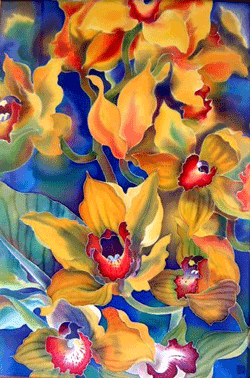 |
|
Madeira Orchids
The silk is tightly stretched and pinned to a wooden frame so that it does not touch the table surface while it it being painted. I use adjustable soft wood frames which I made myself, but there are several types available in good art shops now. You can use an old picture frame or canvas stretcher to start with.
I draw a lot and usually make a number of studies in line and tone on paper first before starting a painting on silk. I feel the discipline of drawing keeps my ‘artist’s eyes’ open and helps me to understand the subject better before I tackle it in paint. A pencil is such a simple and non- threatening tool! It often feels much easier to start a piece of work with a pencil drawing - painting requires such a lot of energy I need to gear up for it! Sometimes I lay a drawing under the silk and trace it very lightly onto the silk with a 3B pencil, or more often I work directly onto the silk either by drawing in the linear composition with pencil first or, If I am feeling brave, directly with gutta. Pencil lines and spirit - based gutta will not wash out so a drawing on silk needs to be accurate. Although this method needs more confidence (as mistakes cannot be rectified or concealed) the finished work tends to retain a freshness which a traced drawing can lose. Although I plan a silk painting as a linear composition, with a balance of shapes and a sense of movement, I also like to like to leave some leeway for the painting to evolve in it’s own way, so the drawing tends to be fairly minimal and just acts as a guide for the placement of resist lines and washes. I have an idea of how I want the finished painting to look, but this invariably changes as the painting progresses. I do not try to control the process completely and enjoy the element of surprise which accompanies silk painting. I find the process both relaxing and exciting and am never entirely sure where a painting is taking me. It usually tells me what it wants if I give it time and do not try to dominate it with intellect! Having said that, I do have a pretty clear idea about what I want to say in a piece of work. I paint what I love; what excites me visually. That is always my starting point and I try to remain true to that throughout the painting process. It is very easy to get side - tracked and forget the original intention of the painting, so sometimes I write down what the focus of the work is about. I find these notes help me not to lose my way on the journey. |
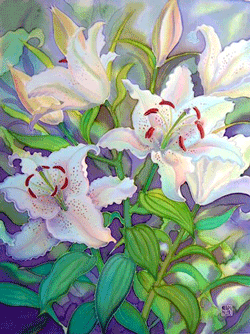 |
|
Stargazer Lilies
As with all painting media, there are lots of different silk painting techniques for creating particular effects: wet on wet,wet on dry, over painting, salt texturing, discharging and water and alcohol patterning to name but a few. Gutta can be applied in layers over previously painted areas or over a preliminary wash, but in this demonstration of a basic silk painting technique, the entire drawing is made in gutta first and then the colours are applied wet into wet and wet on dry. When clear gutta is applied on white silk the lines remain white in the finished painting. When it is applied over coloured areas it reserves these colours in the finished work. I used a gutta bottle fitted with a .5 mm nib to draw the resist lines. The lines need to be unbroken and without gaps where they join to prevent the colour escaping. The nib is pressed against the silk as it is drawn along, and the plastic bottle is gently squeezed to keep the gutta flowing. TIP: if you are not sure if your line will hold the colour, paint with a little clear water first and see if the barriers hold up! |
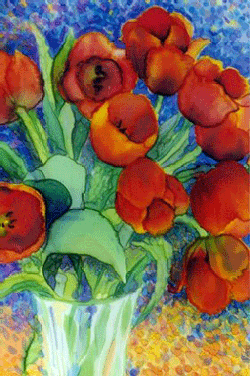 |
|
Tulips in a Vase
For me, the excitement and pleasure of working on silk never wanes. The experience of painting is endlessly intriguing. The brush is touched on the silk and immediately the surface is suffused with spreading colour, filling the spaces between the resist lines as if by magic. Colours added to a damp wash blend and diffuse gently, creating surprising tones. Further colours or touches of water on dry areas of colour displace the under painted colour, creating loose, ragged edges unlike any effect in another medium. As with all types of painting, it really needs to be experienced to be appreciated! If you are new to silk painting, I urge you to have a go. Who knows, you may find it just the medium you have been waiting for!
All paintings © The artist |
| |
|
|
| |
|
|
| |
|
|
|
|

